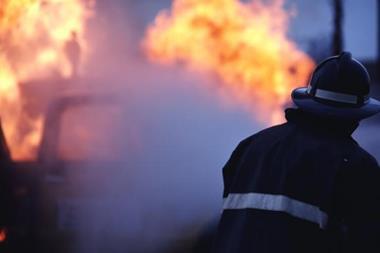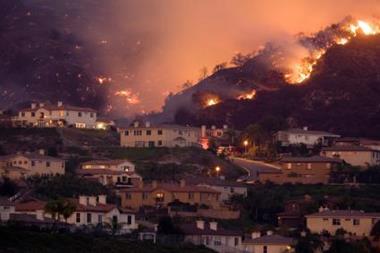The discovery that he definitely did not want a career in the steel industry propelled a young graduate mechanical engineer in North Carolina to New York City and into the arms of the insurance industry.
By Lee Coppack
Little more than 10 years later, the young man was spearheading a revolution in property catastrophe reinsurance underwriting at a new Bermuda company, Renaissance Re.
Fourteen years later and now 48, Bill Riker is giving up his full time positions as president and chief underwriter of RenRe at the end of 2007, partly for health reasons, and staying in the United States, where he had returned about three years ago to concentrate on the company’s substantial business there. He is unlikely to leave the world of catastrophe risks, however.
Bill’s story is that having escaped the steel works and moved to New York, he found work as a trainee in the actuarial department of the Insurance Services Office (ISO). After about nine months, he got a call from a headhunter who asked if he wanted an interview for a job in reinsurance. “What’s that?” asked Bill. “Don’t worry,” the headhunter told him. “Just go to the interview.”
He did, and soon he found himself in the reinsurance department of a division of what was then the Royal Group, which eventually merged into Royal&SunAlliance. He was there for nine years and during that time rose from a junior underwriter to head of underwriting. He was always interested in finding more sophisticated ways of rating catastrophe business and in making use of the growing computing power. Insurance companies were among the earliest users of computers, large room-filling mainframes, but at this stage they were used for data processing and accounts.
“I remember buying my first computer in 1985 and doing some business related work on the computer at home. When my bosses saw what I’d done, they asked if I could bring the computer into the office. It was the size of a small suitcase.”
In 1987, Bill met a kindred spirit, Karen Clark, the founder of catastrophe modelling company Applied Insurance Research (AIR). Karen set up AIR that same year, but it was Hurricane Andrew in 1992 that really galvanised interest in cat modelling. When Karen and Bill met in the late autumn of 1992, she persuaded him to leave the Royal and join AIR.
Among the most sophisticated clients of AIR and the other modelling companies were the new Bermuda property-catastrophe reinsurers. Eight companies were established on the island between 1992 and 1994 to take advantage of the huge rise in premiums following Andrew. They were free of the old systems that burdened existing insurers and could exploit the developing catastrophe models and improving computer power to create a more scientific approach to catastrophe underwriting.
Bill found himself spending a lot of time working with one of the companies in particular, RenRe, whose founder Jim Stanard is an actuary. Eventually RenRe’s management suggested to Bill that instead of commuting between AIR and RenRe, he simply stay at RenRe. In October 1993, he joined the company, and became vice-president US underwriting. Stanard left the company in 2005, but not before he and Bill helped spearhead the use of catastrophe modelling and a rigorous approach to managing catastrophe exposures. Of the eight original property-catastrophe reinsurers, only RenRe remains an independent specialist.
Quantitative analysis
Says Bill, “I was a firm believer in the power of rigorous quantitative analysis in the business and in the use of catastrophe models, which gave us a huge advantage over the processes used historically. Jim was absolutely committed to implementing these things and changing the way business was done.”
Leading up to Hurricane Andrew, the industry had only begun to grapple with an understanding of natural hazard accumulations and portfolio construction. Catastrophe models were in their infancy, but the financial markets were beginning to use increasingly sophisticated modeling and pricing techniques. Some people in the insurance industry were wondering if there were ways of applying them to insurance.
Bill comments, “Jim and I felt that we would be better applying probabilistic criteria to the whole business of catastrophe risk management as opposed to the traditional, zonal aggregate methods. We spent a lot of time discussing different theories. We recognised that in catastrophes you have many correlations to manage and you have a very fat tail distribution which is difficult to measure. The techniques being used on Wall Street at the time made simplifing assumptions that were not really appropriate for catastrophe business.”
When he was at ISO, Bill had been surprised that that the mathematical models it used were not more sophisticated, although it had one of the largest databases in the country, perhaps second only in size to Social Security, powerful mainframe computers and very educated people. The Royal used its computers for accounting, but not for tools to support their decision making.
On the other hand, in its early days, RenRe was accused by its competitors of being almost slaves to its models. “There is no credible catastrophe reinsurer today that does not use some similar technology, but it was great for RenRe as we got a multi-year lead on the others,” says Bill.
“They (models) are simplistic compared to the physical events that they are trying to represent
The sense that they had more rigorous methods of assessing risk changed the company’s way of looking at catastrophe risk. It meant RenRe felt as long as its measurement of risk had not changed, generally neither should the price. “This was fairly heretical in the early days, but we had more confidence in what we believed was good business and what was has not good business. We treated customers that we believed brought us attractive risk in a way they weren’t used to from the reinsurance industry. In 1993-1994 they couldn’t even get in the door with some reinsurers. Customers gravitated to us.”
According to Bill, Hurricane Katrina in 2005 was an event that triggered reassessment of the risks. The industry knew that New Orleans could be flooded, but the real effect of Katrina, coupled with the multiple storms in 2004 and 2005, was that it changed views on the likely frequency of future hurricanes. RenRe discussed the issues with its clients. “No one likes to pay more, but they accept it if they understand the reasons,” comments Bill.
Despite his engineering background, Bill’s view on the failure of the levees in New Orleans in Hurricane Katrina comes from an underwriting perspective.
“I wasn’t well versed in the particulars,” he says, “but we had been concerned about what I would call gratuitous exposures that no one had priced for, like the risk of the levees breaking.”
The insurance industry, he believes, tends to cover remote risks that are ignored in its risk analysis as these risks are considered too difficult to quantify. It then optimistically hopes they will go away, but they do not. RenRe has a cultural commitment that “If we don’t understand a risk, we don’t write it.”
Right answer, wrong reason
The most striking example of this philosophy meant that the company’s claims from the terrorist attack of September 11, 2001 were limited to $150 million gross.
“We had always been concerned,” says Bill, “about the potential for earthquake and fire following earthquake (FFE) in New York City and had felt the industry did not price for this exposure. When 9.11 occurred, we didn’t expect that type of event, but after we got over the shock of it, we assessed our portfolio in relation to our FFE model.
“When we calculated our initial loss estimate, we were within about 10% of the final number. We had never tried to measure terrorism risk, but we had avoided the similar FFE risk, which others had tended to ignore. It turned out to be a similar problem to a large fire event in downtown Manhattan.”
Today, virtually everyone uses catastrophe models, but Hurricane Katrina shook some of the faith in them. Wholesale rejection is equally misplaced as unquestioning faith, Bill believes. “Models can be very precise, but very inaccurate. They are simplistic compared to the physical events that they are trying to represent, so you need a thorough understanding of what underlies these models to know what they are good at and what they are not good at.”
Bill is at RenRe until the end of the year as president and chief underwriting officer but he’s working on the transition. His goal is to continue working with RenRe and other people on new initiatives in catastrophe risk. “I believe that cat risk is very different type of risk from auto or fire. Historically, cat risk has been on reinsurers’ balance sheets because insurance companies originated these risks and they were our clients. Historically, reinsurance companies took the cat risk, diversified it on their balance sheets and it all kind of added up.”
Today, Bill says the ability of reinsurance companies to assume catastrophe risk and make adequate provision on their balance sheets is more and more difficult. He is interested in developing other ways to access capital to support natural catastrophe risks. “There is an imbalance between demand for catastrophe cover, which is growing around 10-15% a year, and diversifying business which has shrunk. Therefore, there is an opportunity for other capital market solutions.”
Bill says that the reinsurer’s job is to help insurers manage risks, but this does not mean the risk needs to stay on the reinsurer’s balance sheet. The time has come to use more creative approaches and spread the risks further across the spectrum of capital providers. He is happy to be involved with another revolution in catastrophe risk management.
Postscript
Lee Coppack is the editor of Catastrophe Risk Management.
Email: lee.coppack@cat-risk.com
Website: www.cat-risk.com















